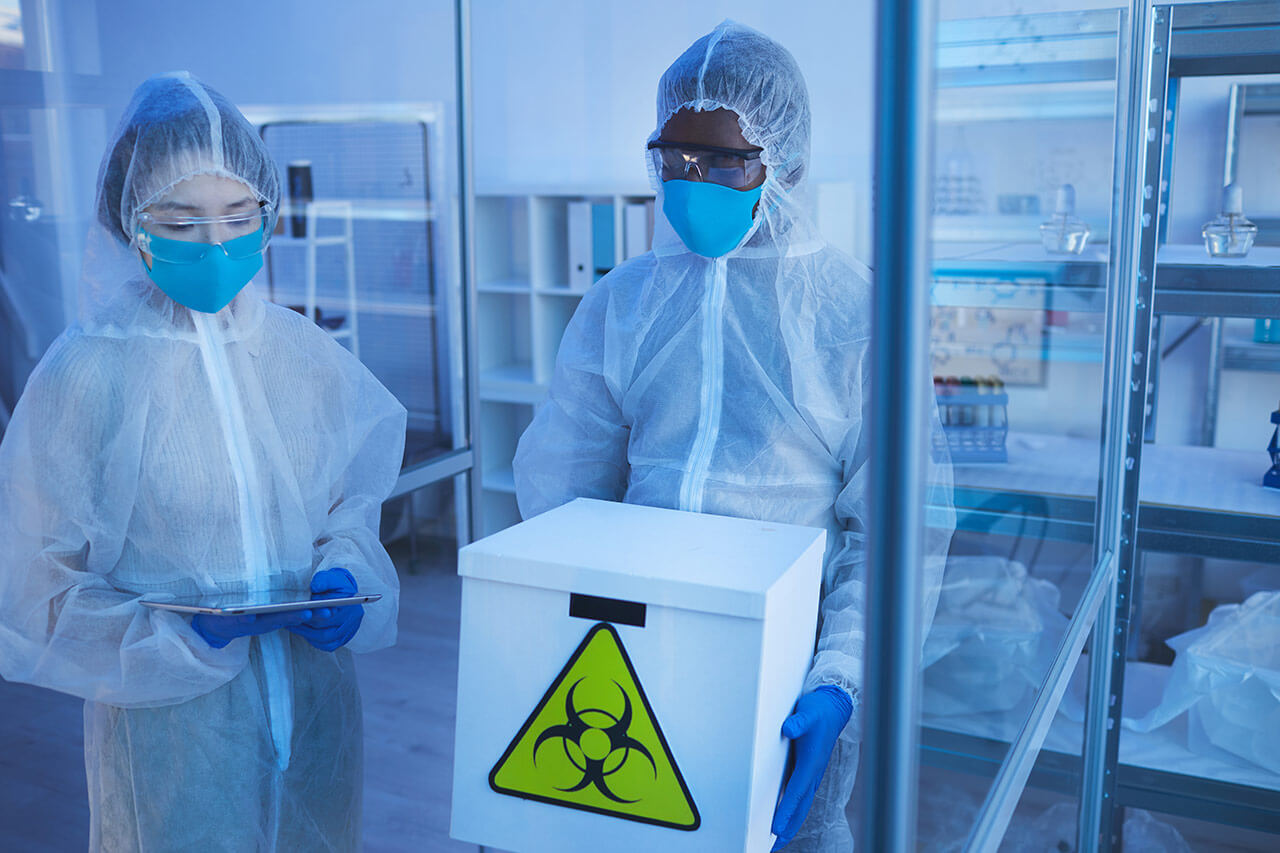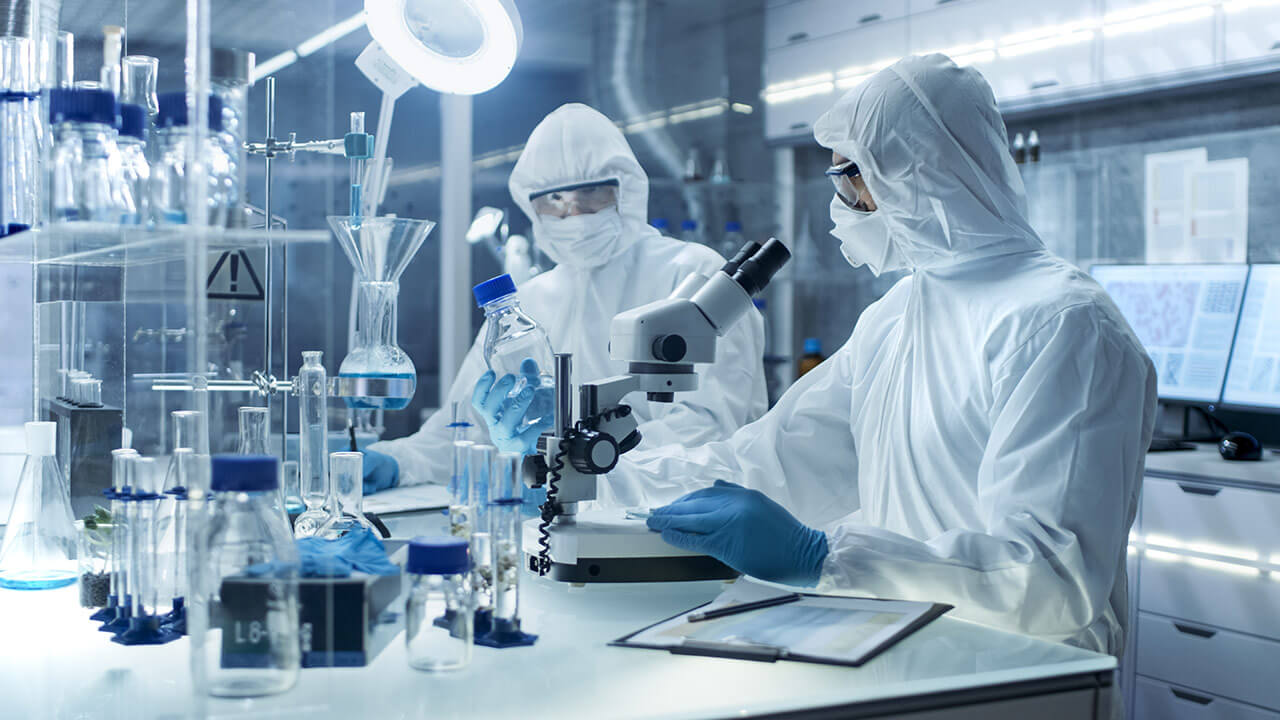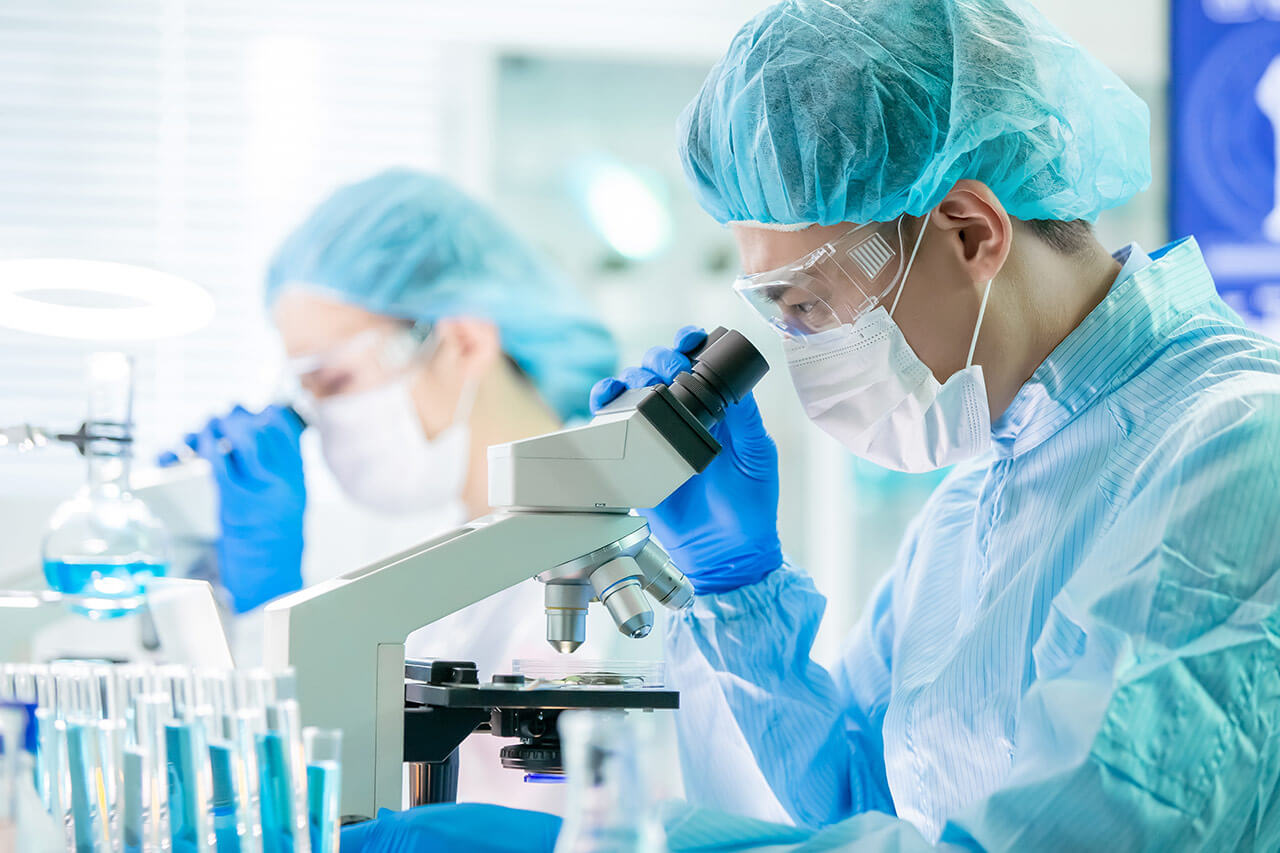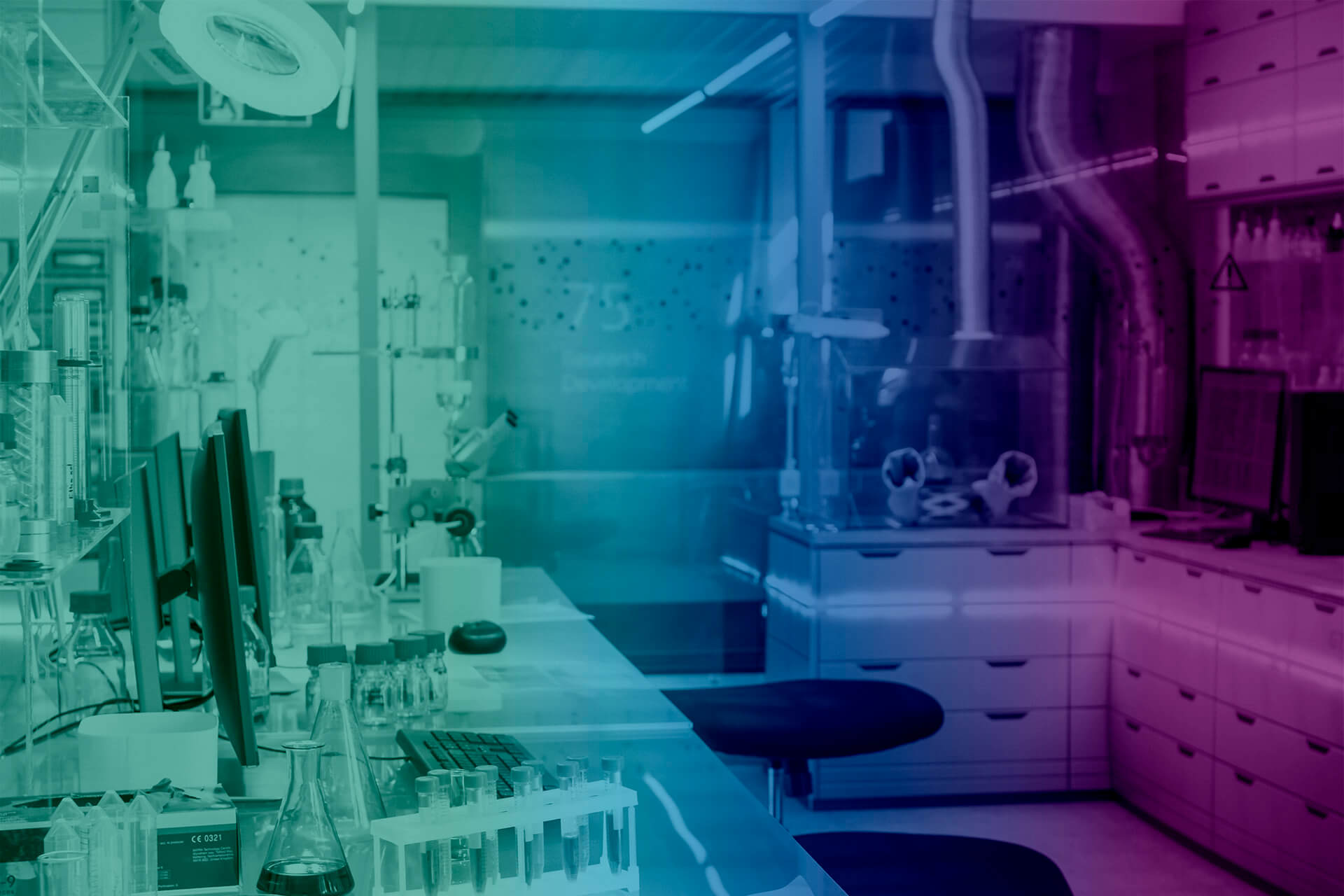High-security and/or high-risk laboratories are highly trained facilities equipped with state-of-the-art equipment, which makes them dangerous and high-risk places. It is therefore vital to be aware of safety standards.
In laboratories all over the world, and especially in the case we are dealing with, high-risk laboratories, there are countless risks that can cause:
- Accidents: falls, cuts, thermal or chemical burns, poisoning, fires…
- Occupational illnesses: due to continuous exposure or not to chemical, physical or biological contaminants.
Thus, work in the laboratory presents a set of varied risks, related to the facilities, the products handled, the energies and living organisms, and the operations carried out. In particular, we are talking about risks with products that are often very dangerous, such as chemicals.
“The implementation of criteria to ensure quality, whether it be obtaining accreditation such as GLP (Good Laboratory Practices), NE 45001 or ISO 9000 certification, clearly demonstrates the correct application of a safety policy.”
Implementing a high level of safety and following the recommendations to guarantee safety in high-risk laboratories is non-negotiable.

Risk assessment & Evacuation, emergency and safety plan
Before a full emergency plan can be implemented, the laboratory, whether or not it is a high-risk laboratory, must have carried out an initial risk assessment, and then update it when working conditions change.
It is this risk assessment that will prevent risk factors from turning into accidents and/or problems, whether they are:
- Not knowing the hazard characteristics of substances.
- Using intrinsically dangerous methods and procedures.
- Poor work habits.
- Inadequate or poor quality laboratory equipment.
- Faulty facilities.
- Non-ergonomic design and lack of space.
- Environmental contamination.
Once this is done, the laboratory will have its own emergency plan. In the case of a hospital laboratory, we have specific regulations on the development of emergency plans.
Implicit in the development of the emergency plan is a policy on fire protection, evacuation and signage that includes risk assessment, existing means of protection, an implementation programme with regular drills to test the effectiveness of the plan and the organisation of a first response team.
Laboratory biosafety levels
The main classification of infectious micro-organisms is by the WHO, which divides them into 4 groups according to the intrinsic risk they pose:
Risk group 1
Micro-organisms with little chance of causing disease in humans or animals, i.e. no risk or very low risk to the individual and the community.
Risk Group 2
Pathogens that may cause disease in humans and/or animals, but are unlikely to pose a serious problem to laboratory workers, the community, livestock or the environment. Moderate individual risk and low community risk.
Risk group 3
Pathogens that usually cause serious disease in both humans and animals, but are not usually transmitted from one infected individual to another. High individual risk and low community risk.
Risk group 4
Pathogens that usually cause severe disease in humans and animals and can be rapidly transmitted, directly or indirectly, from one infected individual to another. Treatment is usually not available. Here there is high individual and community risk.

Keys to bear in mind in laboratories
The activity of a high-risk laboratory, such as a microbiology laboratory, gives rise to different types of risks, especially biological risks, capable of affecting the health of workers, visitors and the community. To this end, the following points must be assessed and stacked:
- Health examinations (surveillance and prevention)
- Individual self-protection awareness
- Hazard identification and risk assessment
- Adopting appropriate containment measures
- Use of scrupulous microbiological techniques
- Training and information to draw up a comprehensive safety plan, follow it and update it.
Together, this will ensure that the laboratory is a safe place, free of accidents and infections contracted there.
General rules in high-risk laboratories
We would like to summarise the basic rules for working in the laboratory, with special reference to organisational aspects, risk prevention and protection policy, storage of products, waste disposal and emergency response.
Basic safety rules for a laboratory
- Have a precise and authorised safety manual.
- It is forbidden to eat, drink, consume any substance inside the study and analysis areas.
- The general ventilation of the laboratory must be checked frequently, as well as the gas installation.
- Regulate the disposal of waste.
- Use personal protective equipment appropriate for each job and risk.
Personal recommendations
- Avoid working alone in the laboratory, especially outside normal working hours and if doing hazardous work.
- Keep gowns fastened at all times.
- Do not leave personal items on work tables.
- Keep hair tied back.
- Collect and clean up immediately all spills of liquids, chemicals or biological samples, however small.
- Wash hands before leaving the premises.
Unattended operations
The basic risk of leaving complex laboratory apparatus and facilities operating unattended for “x” amount of time is explosion, fire and contamination by emissions or spills. This requires automatic monitoring devices for energy sources and fluid circulation, which can detect changes in parameters.
Working recommendations
- Do not fill the test tubes more than 2 to 3 cm.
- Heat the test tubes sideways and using tongs.
- Always use racks and holders.
- Hold test tubes with your fingers, never by hand.
- Do not carry test tubes or products in coat pockets.
Risk prevention in the laboratory
Considering the risks that can cause accidents such as falls, cuts, thermal or chemical burns, poisoning, fires… and occupational diseases, resulting from exposure to chemical, physical or biological contaminants, it is essential to work safely.

General rules for working in the laboratory
Given that the laboratory is a place where a large number and variety of hazardous products are handled, in order to avoid contact or ingestion of these products, which are a source of intoxication or accidents, a series of general rules can be established on different aspects applicable to most laboratories.
Organisational recommendations
- The organisation and physical layout of the laboratory should be thoroughly studied and properly maintained.
- The laboratory should be kept tidy and in an optimal state of cleanliness.
Protective measures and equipment
- Gowns are mandatory when working with chemicals and should be 100% cotton.
- Safety goggles must always be available.
- Wear suitable gloves for each task.
- Be familiar with the protection provided by the different personal protective equipment (PPE) for the respiratory tract, fire extinguishers and the application of first aid products in the first aid kit, as well as the mechanisms for receiving possible external help.
- Footwear must be fully enclosed and insulated.
- In short, the laboratory must be equipped with PPE and emergency facilities or emergency response elements (eyewash, showers, fire blankets, fire extinguishers, etc.).
Product storage & chemical safety
- All laboratories use numerous chemicals of different composition, highly flammable or polluting substances. It is therefore vital to check the correct labelling of chemicals received in the laboratory, to label prepared solutions appropriately and not to reuse containers for other products without removing the original label.
- Keeping stock to a minimum operational level increases safety and reduces costs.
- A dedicated location (storage room, preferably outside the laboratory) with appropriate signage is necessary.
- Use safety cabinets of at least RF-15 and explosion-proof or increased safety refrigerators.
Transfer of products
- If possible, transfer small quantities of liquids or do so in a dedicated area.
- Transfer of flammable substances away from heat sources.
- When transferring toxic, irritant and corrosive substances, wear protective clothing appropriate to the risks of the product.
- Avoid spillage with funnels, dosing devices or siphons.
Waste and waste management
- Inventory of all products considered as waste.
- Definition of groups based on their physico-chemical characteristics, incompatibilities, specific hazards and/or subsequent treatment and disposal.
- Consider minimisation possibilities considering possible reuse, recovery, neutralisation and disposal.
- Information and instructions for waste disposal in the laboratory should be available.
- Always neutralise solutions before pouring them down the drain.
- Do not store empty bottles uncapped.
- All equipment used must be deposited in specific containers for cleaning or disposal.
- The purification of the material must guarantee its total bacterial elimination.
Emergency and accident response
It is always necessary to consider specific emergency situations in laboratories, and to know how to act accordingly. Some cases would be:
Spills or spillages
The spilled product must be collected immediately, avoiding evaporation and damage to the facilities. The procedure will depend on the characteristics of the product, whether flammable, acid, alkali, mercury, etc.
Contaminated atmosphere
Depending on whether the contamination is weak or important, due to toxicity or explosiveness, action will be taken in accordance with the emergency plan.
Fire
The risk of fire is also foreseen in the emergency plan. If it is high and/or the occupancy of the laboratory is high, the alarm must be raised. There should be two exits with doors that open outwards. When the evacuation of the laboratory is complete, the doors must be closed. And the laboratory must be equipped with portable fire extinguishers (water spray, halogenated, CO2, powder) suitable for the types of fires that are possible.

Responding in case of accidents
It is imperative that all information necessary for action in the event of an accident is posted in a clearly visible place in the laboratory. This should include: what to do, who to notify, telephone numbers, both internal and external (emergency, prevention service, maintenance, ambulance, fire brigade, laboratory manager), addresses and other information that may be of interest in the event of an accident, especially with regard to the rules of procedure.
In the event of an accident, the emergency system (PAS: Protect, Advise, Aid) must be activated. When communicating, we will give a precise message about:
- Place where the accident has taken place.
- Type of accident (poisoning, thermal or chemical burn, injury, etc.).
- Number of affected persons or victims.
- Apparent state of the victims (consciousness, bleeding, breathing, etc.).
- Do not hang up before the caller has given permission, as additional information may be required.
- Have a person from the laboratory available to receive and accompany the emergency services in order to guide them quickly to the site of the accident.
Types of occupational accidents in a laboratory and what to do about them
There are many types of accidents that can occur in a laboratory. Here is what to do if one of them unfortunately occurs:
- Splashes in the eyes and on the skin: Wash quickly with water for 10-15 minutes, using the safety shower if necessary. Do not attempt to neutralise and seek medical advice immediately with the product label or safety data sheet.
- Dizziness / loss of consciousness due to toxic leakage: Protect yourself with breathing apparatus before approaching the affected person and ventilate the laboratory. Then move the person to a safe place and leave him/her lying on the left side.
- Electrocution: If someone is trapped by a current, turn off the power supply to the appliance causing the electrocution before approaching the victim, then activate the PAS and, if necessary, perform cardio-respiratory resuscitation. Do not give food, drink or products to activate respiration.
- Thermal burns: Wash abundantly with cold water to cool the burned area, do not remove clothes stuck to the skin and cover the burned part with clean clothes.
- Digestive poisoning: Treatment will depend on the poison ingested. It is therefore essential to have the information from the label and the safety data sheet. In case of convulsions or unconsciousness, do not induce vomiting. Activated charcoal or albuminous water is used to prevent absorption of the poison.



